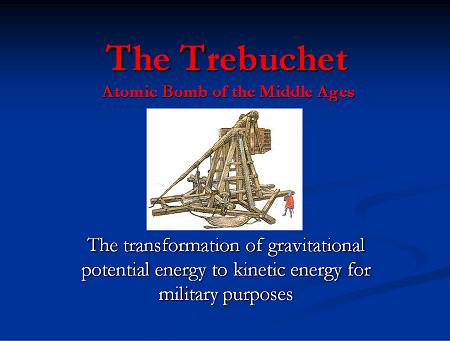How to calculate the velocity of your thrown projectile:
This is easily done with the formula of Velocity = (The rate of gravity) X (The time it takes for the projectile to drop
The rate of gravity is 32.2 feet per second
How to Calculate distance of throw:
Time how long the projectile stays in the air. This is "T" Now multiply this by itself. So if "T" is 4 seconds then you multiply 4x4 to get 16. Now times this by the force of gravity (32.2) And you get 515.2. Then you divide this by 2 and you get the distance. In our example it is 257.6 feet.
The formula is: Gravity times Time Squared then divided by 2
How it works
- The projectile of a trebuchet travels in a Parabola
- To attain the optimum amount of the transfer of energy the counterweight should be allowed to fall as vertically as possible to gain the most momentum from g (9.80 m/s squared).
- To attain maximum range the release point should be between 40 and 45 degrees.
- To gain more velocity (of course at the cost of distance) a lighter projectile will have a later release point and a flatter trajectory and thus more speed. The angle of the release hook may also be adjusted forward to attain the same result with a heavier projectile.
- Why the wheels add energy: The wheels add more power because as the counterweight falls the whole machine moves forward slightly to "meet" the fall thus giving you a more vertical drop leading to more energy being transferred to the throwing arm.
- He added Wheels to his design (You can see the wheels in the picture on the right). They give it a battlefield ready look and they added 25% more power! With the wheels on it this thing looks like it is ready to be rolled out on the battlefield. (The wheels add more power because as the counterweight falls the whole machine moves forward slightly to "meet" the fall thus giving you a more vertical drop leading to more energy being transferred to the throwing arm).
Experimental Data
The maximum range ballast/projectile weight ratio is 133:1 (2000 kg./15 kg.). Interestingly, Warwolf had the exact same ratio (40,000 lbs./300 lbs.).
John has written a presentation on Trebuchets and Transfer of Energy. It has a lot of great information that will be useful to you if you are thinking about making a treb. This is copyright© 2008 John Hall - All Rights Reserved (Thanks John!)

Individual Project
Transfer of Energy
John Hall
History
The trebuchet (O. Fr. - "to overthrow") was a vast improvement on the catapult design in that it used a counterweight and fulcrum to power its throwing arm as opposed to earlier technology which used torsion power by way of twisted rope or sinew. Not only was the trebuchet more powerful than its predecessors, accuracy was improved as well. A catapult had a fixed power, meaning that the entire machine had to be moved to adjust the range. The trebuchet's range could be adjusted simply by adding to or subtracting from the mass of the counterweight. The biggest and most powerful trebuchet ever made, Warwolf , stood over 4 stories tall, weighed 30 tons, had a throwing arm 50 ft. long with a 20 ton counterweight, and could hurl a 300 lb. stone a distance of 900 ft.
Lesser Known History
- Said to have been invented by the Chinese in the 5th century BC, the trebuchet is best known from its use throughout Europe between the 12 th and 15 th centuries before the advent of gunpowder rendered them obsolete.
- Some of the more ruthless besiegers (namely Genghis Khan) got very creative in their choice of projectiles, some of which included casks of burning tar, dung, bodies of Plague victims, beehives, baskets of snakes and scorpions, quicklime, unlucky prisoners-of-war, and even emissaries bearing unsatisfactory peace terms.
- Cortez tried using a trebuchet against the Aztecs as late as 1521, but the very first shot released at an angle of 90 degrees, which led to disaster for the machine and crew.
How it works
- To attain the optimum amount of the transfer of energy the counterweight should be allowed to fall as vertically as possible to gain the most momentum from g (9.80 m/s squared).
- To attain maximum range the release point should be between 40 and 45 degrees.
- To gain more velocity (of course at the cost of distance) a lighter projectile will have a later release point and a flatter trajectory and thus more speed. The angle of the release hook may also be adjusted forward to attain the same result with a heavier projectile.
- Why the wheels add energy: The wheels add more power because as the counterweight falls the whole machine moves forward slightly to "meet" the fall thus giving you a more vertical drop leading to more energy being transferred to the throwing arm.
Experimental Data
The maximum range ballast/projectile weight ratio is 133:1 (2000 kg./15 kg.). Interestingly, Warwolf had the exact same ratio (40,000 lbs./300 lbs.). My model has a ratio of 125:1 (1.25 kg./10 g.).
|
![]()



